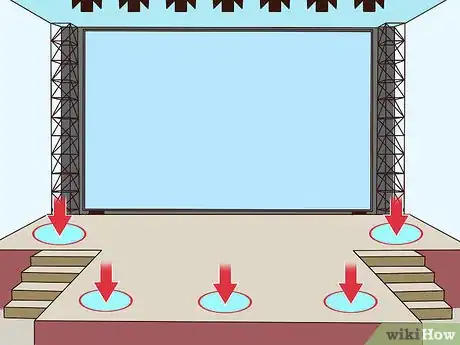This article was co-authored by Tanisha Hall. Tanisha Hall is a Vocal Coach and the Founder and Executive Director of White Hall Arts Academy, Inc. an organization based in Los Angeles, California that offers a multi-level curriculum focused on fundamental skills, technique, composition, theory, artistry, and performance at a conservatory level. Ms. Hall's current and previous students include Galimatias, Sanai Victoria, Ant Clemons, and Paloma Ford. She earned a BA in Music from the Berklee College of Music in 1998 and was a recipient of the Music Business Management Achievement Award.
There are 7 references cited in this article, which can be found at the bottom of the page.
wikiHow marks an article as reader-approved once it receives enough positive feedback. In this case, 100% of readers who voted found the article helpful, earning it our reader-approved status.
This article has been viewed 377,945 times.
As a lead singer, your main job is to keep the audience engaged and entertained. Start by practicing your songs until you know them by heart. While on stage, show the audience your enthusiasm for the music by moving around and interacting with your bandmates. Talk with the audience between songs and reach out to touch them, if you feel safe doing so.
Steps
Interacting with Your Audience and Bandmates
-
1Introduce everyone involved in the show. At the very start of your show, give the audience your name and the name of your band. As the show goes on, go around and introduce each of your band member’s names. It usually works well if you do this right before a song that emphasizes their instrument or their solo.[1]
- For example, if you are introducing your bassist, you could say, “This is Andrew and he’s about to show you what he can do on the bass.”
- Try to repeat your band’s name frequently during a gig. You might yell,” Again, we are Orion and we are happy to be here with you tonight Milwaukee!” Otherwise, people who missed your introduction might spend your entire set wondering who you are.
- It’s also nice to give a quick shout-out to the organizers, the bartenders or servers, and anyone else who has helped make your show a success. Keep these remarks brief, quick, and energetic.
-
2Reference the location or venue. Audiences want to feel a connection with you and talking about their city helps to create that feeling. Find something unique that stands out about the location or venue for you or your band and mention it in your introduction.
- For example, you could say, “We recorded our last album in this city. We love Milwaukee!”
Advertisement -
3Talk with your audience in between songs. After you finish each song, take a few minutes to tell your audience a quick story about the band. You can even use the story as a transition into the next song, especially if it describes the inspiration for it. If you can connect what you are staying back to the venue or city that you are performing in that’s even better.
- For example, you might say, “This next song was written two years ago right after we performed in this exact same place.”
- Avoid making inside jokes on stage. They separate you from your audience and can ruin their experience.[2]
- Don't be afraid to renegotiate your place with the microphone. Some people feel that once they find their ideal distance from the mic, they need to keep their face there. This can get awkward when you have to stop singing and need to speak to people.[3]
-
4Encourage the audience to clap or sing along. Before you start a song, tell the audience that you want them to help you sing the chorus or keep the beat. When the chorus hits, angle your mic toward the audience. Or, clap along with the beat to show them how it’s done. This works best if you do it with a particularly popular or catchy tune.
-
5Take and post pics or video to social media sites. Your audience is likely taking plenty of photos of you, so do the same for them. In between songs, put the audience behind you and take a quick selfie for Instagram. You could also take a short video of the audience singing along and post it.
- Give your audience a quick warning before snapping a pic. You might say, “I’m going to take a quick video of you all. Make some noise.”
-
6Listen closely to other solos. When the other members of your band start to play a solo, walk over to them. Nod or pantomime encouragement for them. You can even start clapping with their rhythm. This will give you a bit of a break from performing, while also showing your appreciation for your fellow musicians.[4]
Keeping Your Audience’s Attention
-
1Know what your audience expects and wants. Spend some time thinking about the type of person who will attend one of your performances. Will they by young or old? Experienced concert goers or new to the scene? People who will want to dance or sit still? Create a “model” concert goer in your mind and then make it your quest to entertain them.[5]
- For example, if your songs all have a strong rhythm, then people may start to dance in the audience. You may look out of place if you just stand on the stage without moving. Instead, you might want to do a few moves while singing to lead the way.
-
2Change it up a bit for each song.[6] No one wants to watch the exact same stage performance for hours on end. That’s why it’s important to make slight alterations to your stage presence for every song that you play in a set. If it’s a ballad, you might simply stand behind the mic and let your emotions show through on your face. If it’s a yelled anthem, then you can hold the mic and jump around the stage to the rhythm.[7]
- Pay attention to how your playlist develops. You want a list that showcases all of your song types and mixes them in. Another benefit of this is that you’ll get small breaks from movement during slower songs.
-
3Vary your stage positioning. Always be aware of where you are standing on the stage. Before your performance, decide exactly how much of the stage that you’ll use. You can plan to stay in one spot toward the front, however, it may be more interesting to the audience if you walk around to all areas on stage. This also gives the maximum number of people a good view of you performing, so they’ll feel like they’ve gotten their money’s worth.
-
4Give your band members the spotlight during their solos. You can move slightly to the back or side of the stage, as other band members play their solo. Talk with your band members about your stage positioning. That way they’ll know where you’ll be for each song. This will give them some freedom to move around as well.
-
5Develop your own style of dress. Audiences will spend the majority of your set staring directly at you, so you must look the part. A good rule of thumb is to take your standard style and amplify it to the extreme. Wear clothes that are appropriate for the venue that you are at and the type of music that you are performing, too.[8]
- For example, if you are singing at a summer music festival, then wearing an evening gown or full suit will leave your audience confused. Instead, stay cool by wearing a loose dress, shorts, or jeans.
- Just like any stage performer, make sure that your audience can actually see what you are wearing. Intricate designs are not really a good idea onstage. Go with big, bold patterns and colors that are visible from a distance.
Putting on a Professional Show
-
1Practice.[9] Spend time learning all of your songs by heart, that way you won’t have to worry about forgetting or missing any lyrics. Play practice sets with your band or back-up singers so that you can work on any potential issues in advance. Have someone videotape you performing a set on stage. Then, look over the video for ways that you could improve.[10]
- Don’t be too concerned about over-preparing before an event. Practicing will actually make it more possible for you to relax and enjoy performing on the day of.
- Make sure to attend all practice sessions at the venue as well. This will give you a better feel of the space, so you’ll know what might work for your performance and what won’t.
-
2Attend any sound checks. You want to work out any kinks or technical glitches well before the audience arrives. Make sure that your instrument or mic is hooked up properly and get to the venue early to call out your “check one, check two…” You can also use this opportunity to talk with the stage or sound technicians for the venue to see if they have any ideas for how you can enhance your performance.[11]
- For example, the technicians may be able to adjust the lighting so that it focuses more on you front and center.
- You can also work with an engineer or a sound manager to make sure the mic is calibrated in the way you like for your voice. For instance, you might prefer to have a little bit more bottom end in your voice, or to have a little bit more reverb.[12]
-
3Stay hydrated on stage. Bring up a bottle of water and set it near the mic. Or, stand to the side of the stage and grab a quick drink while other band members are playing. Room temperature water is the best for your vocal cords.[13]
-
4Ignore any mistakes. If you accidentally forget a lyric or mess up a note, just keep going. If anyone in the audience notices they’ll likely think that you are just improvising. If someone in your band messes up, try not to draw attention to it. If the sound is dropped or another major mistake occurs, keep a sense of humor about it.[14]
- For example, you might say to the audience, “I’ve noticed my mic is out, so while they work on it we’re going to listen to my bandmates for a bit.”
- People with great stage presence aren't necessarily trying to cover up every single bad thing that happens. The audience might be able to smell the fakeness and get turned off by it. Instead, audiences like performers who seem as relaxed as they would be if they were hanging out with good friends.[15]
-
5Don’t fizzle out at the end. Your adrenaline will keep you going for most of your performance, but it can be easy to lose energy towards the end. Keep up the pace by adding lively songs to the end of your set. Also, use a few relaxed moments to thank your audience and to express your appreciation for them listening to you.
- If you move around a lot on the stage while singing, you’ll be able to last longer if you are in good shape. Try to eat right, exercise, and get enough sleep.
Expert Q&A
-
QuestionHow can I improve my stage presence?
 Jonathan StancatoJonathan Stancato is a Holistic Voice Coach and the Founder of Inside Voice, an approach to improving one's voice and singing abilities through a mind-body 5-octave approach developed while he was working at the Royal Academy of Dramatic Art in London. He serves clients online and in-person in the New York City metro area and has taught students in theatre conservatories, music festivals, mindfulness organizations, TED Conferences, colleges, choirs, and corporations. Jonathan has extensive training in extended voice (Richard Armstrong/Roy Hart), Hindustani classical vocals (Michael Harrison), and trance singing (Thomas Richards/Grotowski Workcenter).
Jonathan StancatoJonathan Stancato is a Holistic Voice Coach and the Founder of Inside Voice, an approach to improving one's voice and singing abilities through a mind-body 5-octave approach developed while he was working at the Royal Academy of Dramatic Art in London. He serves clients online and in-person in the New York City metro area and has taught students in theatre conservatories, music festivals, mindfulness organizations, TED Conferences, colleges, choirs, and corporations. Jonathan has extensive training in extended voice (Richard Armstrong/Roy Hart), Hindustani classical vocals (Michael Harrison), and trance singing (Thomas Richards/Grotowski Workcenter).
Voice Coach To make even the simplest actions and songs heartbreakingly beautiful, don't focus on hiding your nerves, anger, or whatever else you might be dealing with. Instead of focusing on smiling, showing everything is okay, and communicating that you're a performer with a capital P, just allow yourself to be emotionally transparent with your audience. This authenticity will go a long way towards making you a better performer.
To make even the simplest actions and songs heartbreakingly beautiful, don't focus on hiding your nerves, anger, or whatever else you might be dealing with. Instead of focusing on smiling, showing everything is okay, and communicating that you're a performer with a capital P, just allow yourself to be emotionally transparent with your audience. This authenticity will go a long way towards making you a better performer. -
QuestionWhat can I do to develop stage presence?
 Tanisha HallTanisha Hall is a Vocal Coach and the Founder and Executive Director of White Hall Arts Academy, Inc. an organization based in Los Angeles, California that offers a multi-level curriculum focused on fundamental skills, technique, composition, theory, artistry, and performance at a conservatory level. Ms. Hall's current and previous students include Galimatias, Sanai Victoria, Ant Clemons, and Paloma Ford. She earned a BA in Music from the Berklee College of Music in 1998 and was a recipient of the Music Business Management Achievement Award.
Tanisha HallTanisha Hall is a Vocal Coach and the Founder and Executive Director of White Hall Arts Academy, Inc. an organization based in Los Angeles, California that offers a multi-level curriculum focused on fundamental skills, technique, composition, theory, artistry, and performance at a conservatory level. Ms. Hall's current and previous students include Galimatias, Sanai Victoria, Ant Clemons, and Paloma Ford. She earned a BA in Music from the Berklee College of Music in 1998 and was a recipient of the Music Business Management Achievement Award.
Vocal Coach Try changing the inflection on words and emphasizing phrases in the song to add your own personality to it. Keep the audience engaged by involving them with crowd chants, clapping, or dancing.
Try changing the inflection on words and emphasizing phrases in the song to add your own personality to it. Keep the audience engaged by involving them with crowd chants, clapping, or dancing. -
QuestionBut what if someone throws something at me?
 Community AnswerNot likely. If it happens, though, and you're quick enough, catch it and throw it back!
Community AnswerNot likely. If it happens, though, and you're quick enough, catch it and throw it back!
Warnings
- Don’t overindulge in alcohol before performing. No one wants to pay to hear a drunk singer.⧼thumbs_response⧽
References
- ↑ https://spinditty.com/learning/Things-You-Should-Always-Say-on-the-Mic-When-Your-Band-is-Performing-on-Stage
- ↑ http://www.catch-22productions.com/stagepresence.html
- ↑ Jonathan Stancato. Voice Coach. Expert Interview. 31 March 2020.
- ↑ https://www.theguardian.com/music/2009/may/10/tips-stage-performance-singing
- ↑ http://blog.sonicbids.com/5-ways-to-improve-your-stage-presence
- ↑ Tanisha Hall. Vocal Coach. Expert Interview. 27 March 2020.
- ↑ http://diymusician.cdbaby.com/musician-tips/top-5-mistakes-musicians-make-with-their-live-show/
- ↑ http://www.catch-22productions.com/stagepresence.html
- ↑ Tanisha Hall. Vocal Coach. Expert Interview. 27 March 2020.
- ↑ https://www.theguardian.com/music/2009/may/10/tips-stage-performance-singing
- ↑ http://www.catch-22productions.com/stagepresence.html
- ↑ Jonathan Stancato. Voice Coach. Expert Interview. 31 March 2020.
- ↑ http://www.catch-22productions.com/stagepresence.html
- ↑ http://www.catch-22productions.com/stagepresence.html
- ↑ Jonathan Stancato. Voice Coach. Expert Interview. 31 March 2020.
- ↑ https://spinditty.com/learning/Things-You-Should-Always-Say-on-the-Mic-When-Your-Band-is-Performing-on-Stage
- ↑ http://www.catch-22productions.com/stagepresence.html















































































